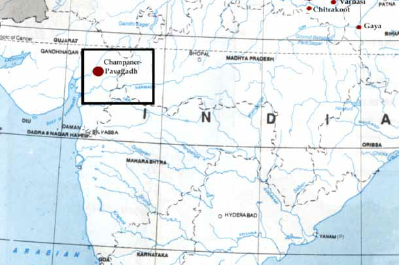Champaner-Pavagadh Archeological Park
- The park is located in the Panchmahal district of Gujarat.
- It was inscribed as the World Heritage Site in 2004.
- The city of Champaner was founded during the time of the Rajput king Vanraj Chavda of the Chavda dynasty in the 8th century.
- The archaeological park comprises Hindu and Jain temples and several mosques, along with citadels, a palace, military structures and stunning water installations.

- Most of the temples date back to 14-15th centuries, with the oldest from 10th century which is the Shaivite Lakulisa temple.
- The park may derive its name from the
- Pavagadh hill that is made of reddish-yellow coloured stones, one of the oldest rock formations found in the country.
- Pigmentation of the igneous rocks of the Pavagadh Hill is often compared to the ‘champaka’ flower or that resemble the flames of fire from which it derives the name Champaner for the town.
- The most interesting feature of the city is its water installation system which is why it is also called as the ‘city of thousand wells’.
Indian Science, Technology and Engineering Facilities Map (I-STEM)
- The government green signaled the project Indian Science, Technology and Engineering Facilities Map (I-STEM).
- It is a national portal that will facilitate college, institution and research organizations to check, reserve and have easy access to even expensive research equipment and facilities anywhere in India.
- The Centre for Nano Science and Engineering (CeNSE) at the Indian Institute of Science, Bengaluru created the portal.
- It is in the process of collating information about scientific and research equipment and facilities available at academic institutions and research organizations across the country.
- The institutions and organizations that have the equipment and facilities will provide access to researchers for both academic and non-academic work through an online reservation system.
- The centre is trying to replicate the Indian Nano electronic Users Programme (INUP) model at CeNSE and IIT Bombay that has been in operation since 2008.
New method for faster typhoid diagnosis
- Indian scientists have developed a rapid and accurate method for diagnosis of typhoid.
- The significance of the method is that it requires minimal blood quantity, besides being accurate and potentially cost-effective.
- Blood-culture based diagnosis of enteric fever, used at present, is time-consuming and requires skilled practitioners and costly instruments.
- The method, according to the study, has the potential for clinical use due to its high detection levels and ability to identify cells which can cause disease in a quicker turnaround time.
- Typhoid Fever is a gastrointestinal infection caused by Salmonella enterica typhi bacteria.
- It is transmitted from person to person through the fecal-oral route where an infected individual passes the infection to another person when handling food and water.
Exploded Asteroid
- A European team of researchers analyzed the composition of diamonds locked up in rocks left scattered in the Nubian desert of northern Sudan after an asteroid dubbed 2008 TC3 crashed into Earth.
- The asteroid that was exploded in Earth’s atmosphere in 2008 was a fragment of a Solar System planet that existed billions of years ago.
- They concluded the precious stones must have formed at pressures that could only have existed on a long-lost Mars- to Mercury-sized planet.
- The parent planet was about as large as Mars or Mercury, and was formed in our Solar System’s first 10 million years before being shattered to pieces.
- These are the smallest two planets in our Solar System, which was forged some 4.6 billion years ago.
- This finding boosts the theory that today’s Solar System planets were forged from the remains of tens of large “proto-planets“.
Agasthyamala
- The Agasthyamala Biosphere Reserve, established in 2001, is spread across the States of Kerala and Tamil Nadu.
- It is located in the southernmost end of the Western Ghats that hosts one of the most diverse ecosystems in peninsular India.
- It constitutes an important biogeographical hotspot within the Western Ghats.
- It includes three wildlife sanctuaries - Shendurney, Peppara and Nayar, as well as the Kalakad Mundanthurai Tiger Reserve.
- The Reserve contains moist forests, tropical wet evergreen and deciduous rainforests, plains and grasslands, nourished generously by several rivers.
- Slender loris is found in this region.
- It was included in the Man and the Biosphere program of UNESCO.
- The Agasthyamala Biosphere Reserve was brought under the Biodiversity Conservation and Rural Livelihood Improvement Project, a program assisted by World Bank.
Air pollution chokes the world
- According to the annual State of Global Air Report long-term exposure to air pollution contributed to an estimated 6.1 million deaths across the globe in 2016.
- More than 95% of the world’s population is breathing unhealthy air, with India and China jointly contributing to over 50% of global deaths attributed to pollution.
- India topped China for early deaths from outdoor air pollution with 1.1 million in 2016.
- Air pollution was the fourth-highest cause of death among all health risks globally, coming in below high blood pressure, diet and smoking.
- India, Pakistan and Bangladesh have experienced the steepest increases in air pollution levels since 2010.
Source: PIB, The Hindu, Business Standard

